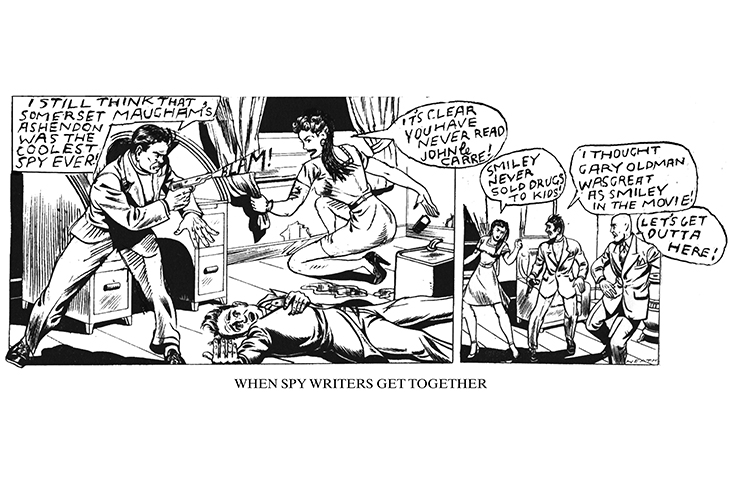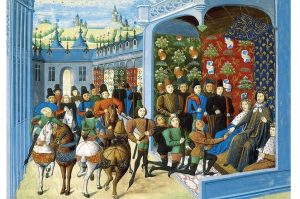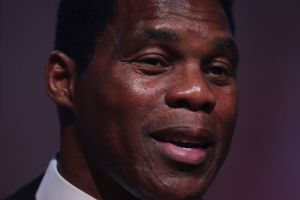In the middle of December, for reasons I’m coming to, I woke early in a posh hotel. I lay semi-dozing while my partner, Jo, was in the shower, and eventually worked out how to tune the bedside radio, an internet device, to BBC Radio 4. The six o’clock pips sounded as a bathrobed Jo emerged, earbuds in place: on her digital radio she heard the headlines some seconds ahead of me, and as she sat on the bed, her smile faltered. What’s the matter, I asked. John le Carré’s died, she said. A heartbeat or two later, while the internet transmission caught up with the digital, the radio confirmed this. John le Carré had died. And then, after a similar timelag, the news landed somewhere inside me. John le Carré had died.
We spent much of the morning in isolation. We were visiting a TV set where an adaptation of my novel Slow Horses was being filmed, and had to be proved COVID-free before we were allowed to mingle. It would be bad form, and very expensive, to infect anyone famous. Jo worked and I read and, when patchy WiFi allowed, checked my emails. Will Smith, the lead writer on the show, got in touch; we shared our memories of an evening at the Royal Festival Hall three years ago, listening to le Carré discuss George Smiley. A gifted mimic, he treated us to his impersonation of Alec Guinness on the phone (‘How did you know it was me?’) while other incarnations of Smiley appeared on screens behind him. They included images of Gary Oldman, who played George in the movie of Tinker Tailor Soldier Spy. I remember first seeing Oldman as Sid Vicious in Sid and Nancy, playing the doomed young punk with the intensity of an unexploded bomb. It would have been unthinkable then to imagine him as Smiley, but I’d like to pretend there’s a more obvious line of succession between Sid and Jackson Lamb, the guise Oldman adopted when we watched him, a little later, dominate a scene involving seven or eight other cast members. He filled the role seamlessly, delivering a line — written by Will, not me — which made us laugh out loud. We watched the scene performed five or six times, and it still made us laugh on the sixth.
The set — Slough House — is huge, full of drab offices and gloomy staircases, some of which end nowhere. The color scheme is nicotine and beige. Jamie Laurenson, who nursed the TV series into being, took a photo of me sitting at Lamb’s desk, going through his drawers. A scatter of aspirin, empty cigarette packets, a bottle of whisky, two glasses. Jamie pointed to a small patch of tinsel Sellotaped to the ceiling, a Christmas decoration ineffectively removed, and it felt like someone had been peeping inside my head. Through the windows I could see Aldersgate Street: a giant diorama wrapped around the set. I’ve never seen a photograph so big, and couldn’t comprehend the efforts that had brought it into being. It was both patently fake and credibly real; once filtered through a TV camera, it would be indistinguishable from the actual road.
Later, we got to meet Mr Oldman, and we talked for a while of how authors — and indeed readers — feel on seeing books translated on to screens. He remembers le Carré adopting an uncompromising stance. ‘Your movie might turn out shit,’ he’d said. ‘But my book will still be great.’ I said that some of my favorite scenes in the Tinker Tailor movie weren’t in the book, notably the Christmas party. Mr Oldman roared with laughter. He asked le Carré about that, he said. He asked: ‘Did that really happen? Did MI6 have Christmas parties?’ ‘Oh yes,’ le Carré had replied, and went on to say that one year it got so out of hand — things thrown out of windows and so on — that the police were called. This delighted me beyond words. The neighbors called the cops to a spooks’ Christmas bash? I have to put that in a book.
Back on set we spoke to more cast members, and I noticed that the chairs they’d been assigned had their characters’ names on rather than their own. All the time we were chatting, they were method-sitting. Then, via a pair of monitors, we watched them perform another scene, and through the windows behind them there was movement on the fake Aldersgate Street. This is achieved through some kind of loop, I’m told, which seemed appropriate enough to me when, some hours later, the car taking us to Marylebone drove briefly down the real Aldersgate Street, and I saw again the Barbican, the Tube station, the pedestrian bridge, now all in 3D, or at least that’s how it appeared through the windows. And then the car turned at the lights and I thought about le Carré again, and how much he’ll be missed. And after that, we were on the train.
Mick Herron’s new book, Slough House, is out now. This article was originally published in The Spectator’s UK magazine. Subscribe to the US edition here.


















